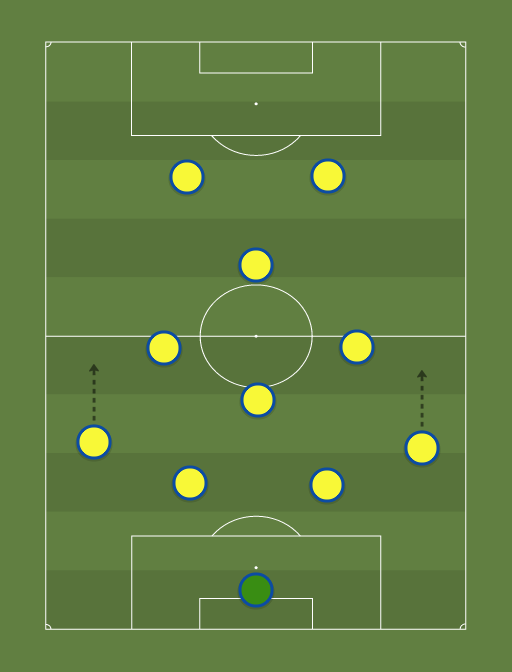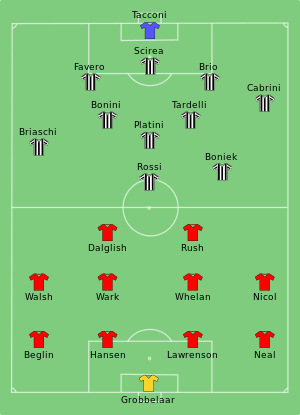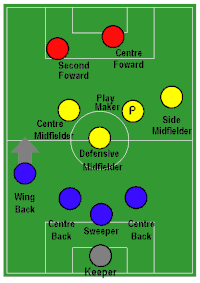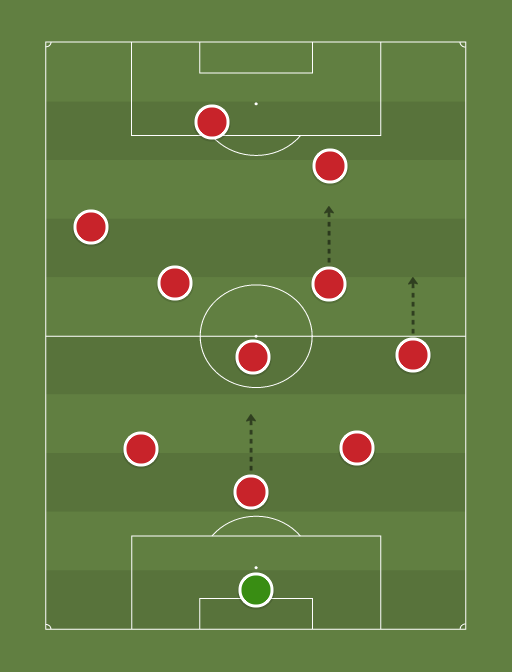Edgar Allan Pillow
Ero-Sennin


....................................... TEAM BRWNED ................................................................................... TEAM PAT MUSTARD ...................................
TEAM BRWNED
Tactical Overview
The "Zona Mista" is an unconventional but thoroughly successful setup that Platini's Juventus played in the 80s, which was a modern update to the more well-known "Catenaccio" played by Inter in the 60s. Examples of Juventus playing it and how it was portrayed visually can be found in the 1985 and 1983 European Cup finals, and the 1984 Cup Winners Cup. More details on the specifics of the Juve setup can be found below:


The primary benefits of the system were that it was typically hard to break down, while getting the most out of its three key players: the immaculate libero, Scirea; the omnipresent playmaker, Platini; and the all-round attacking force of Boniek. It's a fluid setup, reliant on everyone in the team being comfortable in multiple areas of the pitch, reading the game quickly and moving in unison.
The most notable and possibly visually off-putting aspect of it is the lopsidedness of it - one wing back and one tucked in fullback, one wide midfielder and one withdrawn forward. Rather than having gaping holes all over the pitch, this simply meant that many of the team were multi-taskers - Tardelli might pull out to the vacant fullback position to cover a break, or Scirea might gallop up the wing. Bettega might fall back into a defensive position or he might act as a centreforward, while Boniek drifted into space.
Recognising the complexity of the system and the very specific requirements of each role, the team has been selected with all of those dimensions in mind e.g. favouring the "ultimate team man" Cha Bum-kun over the unstoppable maverick, Julinho. The "style of play" sections below provide plenty of detail on the role these players typically played, often with quotes are excerpts from articles expanding on that, and whose role they are occupying from the Juve team. A shorter overview can be found below:
Hapgood, as a pre-WWII fullback, loved that space Gentile played in between fullback and centre back where he could display his class on the ball but would always prioritise closing off any gaps. Moore loved having the freedom to defend proactively and sweep up anything that came in his large zone of play, while on the ball he was dictating the play from deep and moving up through that inside left channel. Amoros was a true dynamo playing alongside Platini in a similarly lopsided team with a narrow midfield, never disregarding his defensive duties but happily being a primary source of width and urgency in attack.
Kanté much like Bonini could do so much more than play as a holding midfielder, but as he's gained experience he has grown to excel there and his energy will be required all over the pitch. Coluna was the midfield general for club and country and relished the all-action role. Mazzola much like Platini was a formidable goal threat from midfield but above all else wanted to be involved in all phases of play, providing the impetus for the team driving forward. Cha Bum Kun played right across the frontline and was recognised by Lothar Matthaus among others as being the ultimate team player, offering that direct threat without sacrificing balance and energy much like Bettega.
Meazza much like Boniek played right across the attack and excelled at driving straight at opposition defences with mazy dribbles, incisive passing and a direct goal threat. Weah puts a different spin on the Paolo Rossi role, taking advantage of the abundance of goal threat around him to play the role of a complete #9, a focal point in the attack stretching the defence every which way.
Kanté much like Bonini could do so much more than play as a holding midfielder, but as he's gained experience he has grown to excel there and his energy will be required all over the pitch. Coluna was the midfield general for club and country and relished the all-action role. Mazzola much like Platini was a formidable goal threat from midfield but above all else wanted to be involved in all phases of play, providing the impetus for the team driving forward. Cha Bum Kun played right across the frontline and was recognised by Lothar Matthaus among others as being the ultimate team player, offering that direct threat without sacrificing balance and energy much like Bettega.
Meazza much like Boniek played right across the attack and excelled at driving straight at opposition defences with mazy dribbles, incisive passing and a direct goal threat. Weah puts a different spin on the Paolo Rossi role, taking advantage of the abundance of goal threat around him to play the role of a complete #9, a focal point in the attack stretching the defence every which way.
Ultimately the system is designed with no opponent in mind. It's built to be flexible and fluid enough to deal with any number of scenarios, with genuinely complete footballers in almost every position, while giving the truly elite players in each zone the freedom and responsibility to work their magic.
TEAM PAT_MUSTARD
Formation/Tactical Synopsis: Possession-orientated 4-4-2 Diamond, with an emphasis on centrally-orientated attacking patterns.
This match has a certain fantasy Serie A vibe, with Brwned nailing his colours to the mast with a well-crafted mirrored Zona Mista tactic, and my diamond formation somewhat suggestive of Ancelotti’s earlier Milan teams. We’re NOT trying to go tiki-taka here, but we’ll aim to have the lion's share of possession here and play the match on the front foot.
Defence:
Three time IFFHS World Goalkeeper of the Year Jose Luis Chilavert takes his place in goal. Ahead of him Willi Schulz, rated world class on 6 occasions by Kicker Magazine in their bi-annual rankings, partners Diego Godin, who conveniently for me continues to elevate his reputation by the match during the current World Cup. Our attacking build up will generally be funneled through our two all-time great playmakers towards the scintillating Brazilian pairing up front, but outlets in the wide areas are still essential and to that end I’ve drafted two athletic attacking full backs in Bessonov and the legendary Facchetti. With Bonhof in particular also providing supplementary width, I feel I've addressed the most obvious potential weakness of the diamond quite well.
Midfield:
With arguably the greatest deep-lying playmaker of all time in Bozsik at the base of the diamond, and the elegant, lavishly gifted classic playmaker Gianni Rivera at its tip, we’re aiming to establish a meaningful edge in possession and midfield control. With two playmakers at either end of the diamond, it was essential to flank them with mobile, powerful ball winners. As a box to box midfielder who also played in both full back positions, Bonhof’s suitability for the role should, I hope, be clear. As ever when attempting to situate an older player in a modern formation, Edwards as the LCM may attract some more scrutiny. I’ll elaborate more in the match thread, but my own stance is that his old left half back role translates well to this LCM engagement, and his own attributes translate even more effectively: Colossal strength and stamina, formidable ball-winning prowess and a redoubtable, team-orientated mentality. More specifically, an acute awareness of his specific responsibility to defend against Brwned’s creative talismans Mazzola Sr. and Meazza, as illustrated by an excerpt from his book, published posthumously:
Attack:
Romario is quite possibly the best centre forward in the draft, and with the likes of Luis Ronaldo and Eusebio on the blocked list he’s a stylistic rarity, with most of the other standouts tending towards the target man category and few possessing Romario’s quicksilver, jinking genius with the ball at his feet. His partner Leonidas, the best player and top scorer at the 1938 World Cup, seems to have been cut from a similar stylistic cloth. Comfortable at inside forward as well as centre forward, he was famously agile and inventive, as well as being utterly prolific.
Restrictions
10s: Leonidas (BRAZIL) Benbarek (MOROCCO)
20s: Bozsik (HUNGARY)
30s: Edwards (ENGLAND) Schulz (GERMANY)
40s: Rivera (ITALY) Facchetti (ITALY)
50s: Bessonov (UKRAINE) Bonhof (GERMANY)
60s: Romario (BRAZIL) Chilavert (PARAGUAY)
70s: Naybet (MOROCCO)
80s: Godin (URUGUAY)
6 x EUROPE
4 x SOUTH AMERICA
2 x AFRICA
1 x ASIA
CL: Rivera, Facchetti
WC: Romario, Bonhof
CA: Romario, Godin[/QUOTE]



